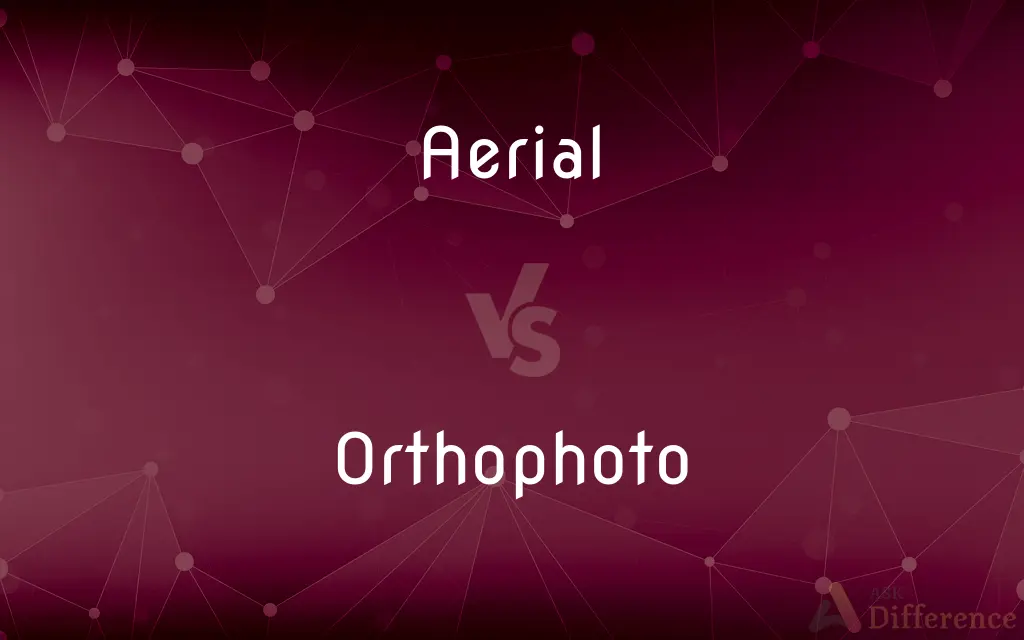Aerial vs. Orthophoto — What's the Difference?
By Urooj Arif & Maham Liaqat — Updated on March 27, 2024
Aerial photography captures images from an airborne platform, while orthophotos are aerial images corrected for distortions to represent the Earth's surface accurately.

Difference Between Aerial and Orthophoto
Table of Contents
ADVERTISEMENT
Key Differences
Aerial photography involves capturing images from an airborne vehicle, offering a bird's-eye view of the landscape. Whereas, orthophotos are a specific type of aerial photograph that have been geometrically corrected, or "orthorectified," to create an accurate representation of the Earth's surface, free from the usual distortions seen in standard aerial photos. This distinction highlights the difference between a general overview provided by aerial photography and the precise, map-like accuracy of orthophotos.
While aerial photos provide valuable perspectives for various applications, including real estate, surveying, and environmental monitoring, orthophotos are particularly useful for creating maps, measuring distances, and planning because they ensure scale uniformity across the image. The correction process eliminates the effects of camera tilt and topographical relief, making orthophotos reliable for technical and analytical purposes.
The process of capturing aerial photographs can be achieved using airplanes, helicopters, drones, or balloons, offering flexibility in terms of altitude and areas covered. On the other hand, the production of orthophotos requires additional processing steps, including digital elevation models (DEMs) for terrain correction, to accurately represent ground features as if the photo were taken vertically above each point on the ground.
Aerial photography allows for the capture of stunning landscapes, urban areas, and events from unique perspectives, providing both aesthetic and informational value. In contrast, orthophotos serve a more functional purpose, being utilized in GIS (Geographic Information Systems), urban planning, and land management to provide a true-to-scale depiction of the surface.
The use of aerial photos is often the first step in the creation of orthophotos. While aerial imagery offers immediate visual data about a location, the transformation into orthophotos through post-processing makes these images a foundational element for precise mapping and spatial analysis projects.
ADVERTISEMENT
Comparison Chart
Definition
Capturing images from an airborne platform
Aerial images corrected for distortions
Primary Use
General overview, real estate, surveying
Mapping, measuring distances, planning
Correction
No geometric correction for distortions
Corrected for camera tilt and topographical relief
Flexibility
Various platforms (planes, drones, etc.)
Requires additional processing steps
Purpose
Aesthetic and informational value
Precise, true-to-scale representation
Compare with Definitions
Aerial
Bird's-eye view photography.
Aerial photography captured the vastness of the Grand Canyon.
Orthophoto
Corrected aerial images.
Orthophotos are used to create accurate city maps for urban planning.
Aerial
Flexible in platforms.
Drones have become popular for aerial photography due to their maneuverability.
Orthophoto
Free from distortions.
The orthophoto accurately depicted the property lines for the land survey.
Aerial
Valuable for diverse applications.
Aerial photography is instrumental in environmental monitoring.
Orthophoto
Involves terrain correction.
The orthophoto was corrected using a digital elevation model to represent the mountain accurately.
Aerial
Provides immediate visual data.
Emergency response teams use aerial photography for assessing disaster areas.
Orthophoto
Utilized in GIS.
Geographic Information Systems rely on orthophotos for accurate spatial analysis.
Aerial
Captures landscapes and events.
The aerial photograph showcased the full extent of the festival grounds.
Orthophoto
Essential for precise mapping.
Orthophotos provide the basis for detailed environmental habitat mapping.
Aerial
Existing, happening, or operating in the air
An aerial battle
An intrepid aerial adventurer
Orthophoto
An orthophoto, orthophotograph or orthoimage is an aerial photograph or satellite imagery geometrically corrected ("orthorectified") such that the scale is uniform: the photo or image follows a given map projection. Unlike an uncorrected aerial photograph, an orthophoto can be used to measure true distances, because it is an accurate representation of the Earth's surface, having been adjusted for topographic relief, lens distortion, and camera tilt.
Aerial
A rod, wire, or other structure by which signals are transmitted or received as part of a radio or television transmission or receiving system.
Orthophoto
= orthophotograph.
Aerial
A type of freestyle skiing in which the skier jumps from a ramp and carries out manoeuvres in the air.
Orthophoto
An aerial photograph that has been geometrically corrected (orthorectified) such that the scale of the photograph is uniform, meaning that the photo can be considered equivalent to a map.
Aerial
Of, in, or caused by the air.
Aerial
Existing or living in the air.
Aerial
Reaching high into the air; lofty.
Aerial
Suggestive of air, as in lightness; airy.
Aerial
Unsubstantial; imaginary.
Aerial
Of, for, or by means of aircraft
Aerial photography.
Aerial
(Botany) Growing or borne above the ground or water
Aerial roots.
Aerial
A radio antenna, especially one suspended in or extending into the air.
Aerial
An acrobatic maneuver performed in midair, as in skateboarding.
Aerial
A flip in which the body turns over sideways with the arms and legs spread similar to a cartwheel.
Aerial
Living or taking place in the air.
The seabirds put on an astonishing aerial display.
Aerial
Made up of air or gas; gaseous.
Aerial
Positioned high up; elevated.
The aerial photographs clearly showed the damage caused by the storm.
Aerial
Ethereal, insubstantial; imaginary.
Aerial
Pertaining to the air or atmosphere; atmospheric.
Aerial
(aviation) Pertaining to a vehicle which travels through the air; airborne; relating to or conducted by means of aircraft.
Aerial
(botany) Above the ground
Aerial
A rod, wire, or other structure for receiving or transmitting radio, television signals etc.
Aerial
A move, as in dancing or skateboarding, involving one or both feet leaving the ground.
Aerial
(photography) An aerial photograph.
Aerial
Of or pertaining to the air, or atmosphere; inhabiting or frequenting the air; produced by or found in the air; performed in the air; as, aërial regions or currents; the aërial maneuvers of a fighter plane.
Aerial
Consisting of air; resembling, or partaking of the nature of air. Hence: Unsubstantial; unreal.
Aerial
Rising aloft in air; high; lofty; as, aërial spires.
Aerial
Growing, forming, living, or existing in the air, as opposed to growing or existing in earth or water, or underground; as, aërial rootlets, aërial plants; the aerial roots of a philodendron.
Aerial
Light as air; ethereal.
Aerial
Operating or operated overhead especially on elevated cables.
Aerial
Operating or moving in the air.
Aerial
A pass to a receiver downfield from the passer.
Aerial
A metallic wire, rod, or combination of rods connected to an electronic device, designed to send or receive radio or television signals.
Aerial
A pass to a receiver downfield from the passer
Aerial
An electrical device that sends or receives radio or television signals
Aerial
In or belonging to the air or operating (for or by means of aircraft or elevated cables) in the air;
Aerial particles
Small aerial creatures such as butterflies
Aerial warfare
Aerial photography
Aerial cable cars
Aerial
Growing in air;
Aerial roots of a philodendron
Aerial
Characterized by lightness and insubstantiality; as impalpable or intangible as air;
Figures light and aeriform come unlooked for and melt away
Aerial fancies
An airy apparition
Physical rather than ethereal forms
Common Curiosities
Why use aerial photography?
Aerial photography is used for its versatility in capturing landscapes, urban planning, environmental monitoring, and providing immediate visual data.
What are the applications of orthophotos?
Orthophotos are primarily used in mapping, GIS, urban planning, and land management for their precise and true-to-scale depiction of the surface.
Can drones be used for both aerial photography and orthophotos?
Yes, drones can capture aerial photographs that are then processed into orthophotos, leveraging their flexibility and accessibility.
How do aerial photographs assist in environmental monitoring?
Aerial photographs provide a comprehensive view of natural landscapes, helping monitor changes, track environmental conditions, and plan conservation efforts.
How does topographical relief affect aerial photographs?
Topographical relief can introduce distortions in aerial photographs, making features appear tilted or at incorrect scales without correction.
How are orthophotos created?
Orthophotos are created by processing aerial photographs with digital elevation models to correct distortions and ensure accurate representation.
What is aerial photography?
Aerial photography involves taking photographs from an airborne platform to capture bird's-eye views of the Earth's surface.
What makes an orthophoto different from a standard aerial photo?
An orthophoto is a geometrically corrected aerial photo that accurately represents the Earth's surface, free from distortions like tilts or topographical relief.
Are orthophotos more expensive to produce than standard aerial photos?
Yes, due to the additional processing and correction steps required, orthophotos generally entail higher production costs.
Why is flexibility in platforms important for aerial photography?
Flexibility allows for tailored approaches to capturing images across different terrains, altitudes, and conditions, maximizing coverage and perspective.
What is the advantage of using orthophotos in GIS?
The accuracy and scale consistency of orthophotos make them invaluable for GIS applications, ensuring reliable spatial analysis and decision-making.
Can aerial photography capture urban and natural landscapes alike?
Yes, aerial photography is versatile, capturing detailed views of both urban developments and natural landscapes from an aerial perspective.
How is the accuracy of an orthophoto verified?
The accuracy of orthophotos is verified through comparison with ground truth data and precision measurements within the correction process.
What future advancements might impact aerial photography and orthophotos?
Technological advancements in drone capabilities, image processing software, and satellite imaging may further enhance the quality, accessibility, and applications of aerial photography and orthophotos.
What role does aerial photography play in disaster management?
Aerial photography provides rapid, comprehensive views of disaster-affected areas, aiding in assessment, planning, and response efforts.
Share Your Discovery

Previous Comparison
Crystallite vs. Crystal
Next Comparison
Meaning vs. NotionAuthor Spotlight
Written by
Urooj ArifUrooj is a skilled content writer at Ask Difference, known for her exceptional ability to simplify complex topics into engaging and informative content. With a passion for research and a flair for clear, concise writing, she consistently delivers articles that resonate with our diverse audience.
Co-written by
Maham Liaqat













































